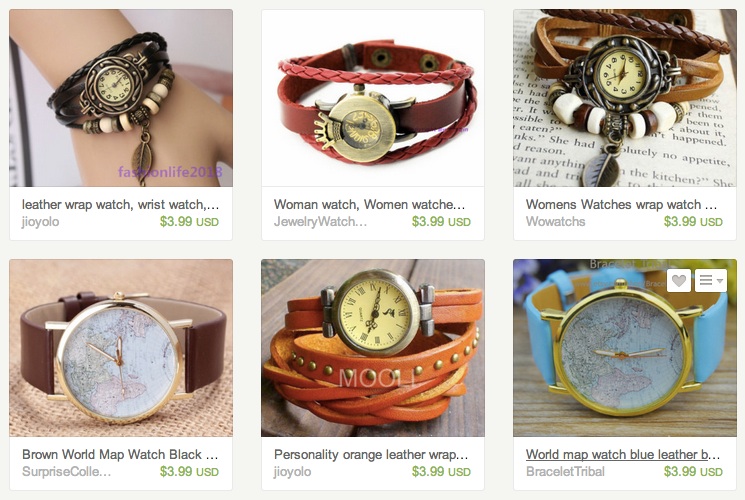Etsy was founded by Robert Kalin, Chris Maguire and Haim Schoppik in the loft of a Brooklyn, NY apartment, where they designed, coded and then launched the site in June of 2005. Today, the company employs 717 employees, hosts around 1.4 million active sellers and pulled in more than $1.93 billion in gross merchandise sales last year.
Their mission at the time was to fulfill a need for an online marketplace where crafters and artists could make their commercial home. Etsy is the complete spirit of handmade; it is curated by individual creativity. For buyers, Etsy is vintage goodies and crafting galore and the more you use it, the better curated its shop recommendations for you become. For sellers, Etsy is an excellent way to connect directly with worldwide buyers from home or a small local shop. The only stipulation? Handmade it must be. Here are a few items you might come across as you browse Etsy from your computer, tablet, or mobile device:

Why is it called Etsy?
Etsy prides itself on being a fun place to work. From its regular communal “Eatsy” lunches to “Crafternoon,” the company culture is lighthearted and full of creativity. However, this lighthearted nature can sometimes get in the way of discovering their secrets. How did Etsy get its name? Well according to their website, it’s a mystery:
“The true origin of the word “Etsy” is a mystery known only to our founders. If someone asks you where the name came from, just make something up. That’s what we do!”
However, in a January 2010 interview for Reader’s Digest, founder Rob Kalin finally revealed the secret: “I wanted a nonsense word because I wanted to build the brand from scratch. I was watching Fellini’s 8 ½ and writing down what I was hearing. In Italian, you say ‘etsi’ a lot. It means ‘oh, yes.’ And in Latin, it means ‘and if.'”

SEE ALSO: Why is Zazzle Called Zazzle?
Sharing is Caring
Etsy’s business model is shared success. As Etsy sellers make money in their shops, so does Etsy. Sellers must list their items for a fee of at least $0.20 USD. After that, each sale on Etsy’s site garners a 3.5% fee for the company. Throw in a little additional revenue from advertising and financial processing, and you have a strong business model that benefits both Etsy and the sellers who operate their shops through the site. The model can be so successful for shop owners. In fact, more than 75% of sellers are creative entrepreneurs who view their shop as a business and almost a third consider it to be their sole occupation and livelihood.
Here’s a little behind the scenes from YouTuber Fran Meneses: illustrator and entrepreneur of Etsy shop Frannerd:
Fran is an excellent example of an Etsy entrepreneur pulling in a bit of additional income through her shop on the site. “My body is Etsy’s on Fridays” she says, but it isn’t her sole occupation. This is pretty typical for most Etsy shop owners. But for a select few others, Etsy is a miraculous outlet for entrepreneurship. Take well-known shop ThreeBirdNest. Through its personal website and Etsy shop selling handmade knitted goods, ThreeBirdNest receives an average of 150 orders every single day. Tally it all up and you have a mother-of-three pulling in an annual revenue of $960,000. How can this be? Owner Alicia Shaffer credits her success to a deep-seated motivation to succeed and provide for her three children, but truth be told, not everyone is so naturally lucky. For Shafer and ThreeBirdNest, it’s hard to say what exactly caused the shop to take off so well; was it the charm of the products themselves? The team Shafer employs? Her use of Pinterest to link items all over the web? Either way, ThreeBirdNest is making a killing.
There is however, another side to the story, for there seems to be a blurred line between what exactly qualifies as “handmade.” Let’s take another look at ThreeBirdNest which has been the center of attention as of late for reselling cheap items from Alibaba and labeling them as handmade. Some would say that Shaffer has crafted for herself one incredible markup; others feel cheated by the mislabeling of the products. Here is the Etsy Handmade Policy itself: Sellers must exhibit authorship (demonstrating that the inception and creation of items begins with the artist themselves), responsibility (demonstrating that the seller knows and is invested in the production of their items) and transparency (demonstrating that all items must be honestly represented in a trustworthy manner). However, with the introduction of some new guidelines in the fall of 2013 that allow outsourcing, it became clear that the handmade issue had taken a turn. China has come into the picture; and with the introduction of hundreds of thousands of discount shops, it seems that the handmade movement has become quite diluted, to the dismay of many loyal artisan shoppers and sellers.

“We know that the lines we’re walking – to protect what makes Etsy special but allow our members’ businesses to flourish – are tricky,” said Engelheart on the company blog.
Do you think that Etsy will ever make its way back to its truly handmade roots? Comment below! Thanks for reading “Why Is Etsy Called Etsy?!” #WhyIsItCalledEtsy
Lauren Cosgrove is a freelance writer passionate about branding, global issues, and the world’s little mysteries. A Pacific Northwest native, Lauren can be found hiking the great outdoors, practicing her dance steps, or illustrating children’s books.






How did Etsy get its name?
Good question, I’ve always been curious about their brand name too. We just covered the story on Rewind & Capture. Learn the full story: https://rewindandcapture.com/why-is-etsy-called-etsy/